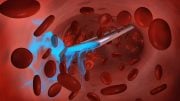
MIT engineers are developing a new type of engineered insulin for diabetes treatment. Tests in mice showed that the modified insulin can circulate in the bloodstream for at least 10 hours and respond rapidly to changes in blood-sugar levels, potentially reducing the need for frequent monitoring and injections for patients.
Engineers from MIT have developed insulin that can circulate in the bloodstream for hours, responding rapidly to changes in blood-sugar levels.
For patients with diabetes, insulin is critical to maintaining good health and normal blood-sugar levels. However, it’s not an ideal solution because it can be difficult for patients to determine exactly how much insulin they need to prevent their blood sugar from swinging too high or too low.
MIT engineers hope to improve treatment for diabetes patients with a new type of engineered insulin. In tests in mice, the researchers showed that their modified insulin can circulate in the bloodstream for at least 10 hours, and that it responds rapidly to changes in blood-sugar levels. This could eliminate the need for patients to repeatedly monitor their blood sugar levels and inject insulin throughout the day.
“The real challenge is getting the right amount of insulin available when you need it, because if you have too little insulin your blood sugar goes up, and if you have too much, it can go dangerously low,” says Daniel Anderson, the Samuel A. Goldblith Associate Professor in MIT’s Department of Chemical Engineering, and a member of MIT’s Koch Institute for Integrative Cancer Research and Institute for Medical Engineering and Science. “Currently available insulins act independent of the sugar levels in the patient.”
Anderson and Robert Langer, the David H. Koch Institute Professor at MIT, are the senior authors of a paper describing the engineered insulin in this week’s Proceedings of the National Academy of Sciences. The paper’s lead authors are Hung-Chieh (Danny) Chou, former postdoc Matthew Webber, and postdoc Benjamin Tang. Other authors are technical assistants Amy Lin and Lavanya Thapa, David Deng, Jonathan Truong, and Abel Cortinas.
Glucose-responsive insulin
Patients with Type I diabetes lack insulin, which is normally produced by the pancreas and regulates metabolism by stimulating muscle and fat tissue to absorb glucose from the bloodstream. Insulin injections, which form the backbone of treatment for diabetes patients, can be deployed in different ways. Some people take a modified form called long-acting insulin, which stays in the bloodstream for up to 24 hours, to ensure there is always some present when needed. Other patients calculate how much they should inject based on how many carbohydrates they consume or how much sugar is present in their blood.
The MIT team set out to create a new form of insulin that would not only circulate for a long time, but would be activated only when needed — that is, when blood-sugar levels are too high. This would prevent patients’ blood-sugar levels from becoming dangerously low, a condition known as hypoglycemia that can lead to shock and even death.
To create this glucose-responsive insulin, the researchers first added a hydrophobic molecule called an aliphatic domain, which is a long chain of fatty molecules dangling from the insulin molecule. This helps the insulin circulate in the bloodstream longer, although the researchers do not yet know exactly why that is. One theory is that the fatty tail may bind to albumin, a protein found in the bloodstream, sequestering the insulin and preventing it from latching onto sugar molecules.
The researchers also attached a chemical group called PBA, which can reversibly bind to glucose. When blood-glucose levels are high, the sugar binds to insulin and activates it, allowing the insulin to stimulate cells to absorb the excess sugar.
The research team created four variants of the engineered molecule, each of which contained a PBA molecule with a different chemical modification, such as an atom of fluorine and nitrogen. They then tested these variants, along with regular insulin and long-acting insulin, in mice engineered to have an insulin deficiency.
To compare each type of insulin, the researchers measured how the mice’s blood-sugar levels responded to surges of glucose every few hours for 10 hours. They found that the engineered insulin containing PBA with fluorine worked the best: Mice that received that form of insulin showed the fastest response to blood-glucose spikes.
“The modified insulin was able to give more appropriate control of blood sugar than the unmodified insulin or the long-acting insulin,” Anderson says.
The new molecule represents a significant conceptual advance that could help scientists realize the decades-old goal of better controlling diabetes with a glucose-responsive insulin, says Michael Weiss, a professor of biochemistry and medicine at Case Western Reserve University.
“It would be a breathtaking advance in diabetes treatment if the Anderson/Langer technology could accomplish the translation of this idea into a routine treatment of diabetes,” says Weiss, who was not part of the research team.
New alternative
Giving this type of insulin once a day instead of long-acting insulin could offer patients a better alternative that reduces their blood-sugar swings, which can cause health problems when they continue for years and decades, Anderson says. The researchers now plan to test this type of insulin in other animal models and are also working on tweaking the chemical composition of the insulin to make it even more responsive to blood-glucose levels.
“We’re continuing to think about how we might further tune this to give improved performance so it’s even safer and more efficacious,” Anderson says.
The research was funded by the Leona M. and Harry B. Helmsley Charitable Trust, the Tayebati Family Foundation, the National Institutes of Health, and the Juvenile Diabetes Research Foundation.
Reference: “Glucose-responsive insulin activity by covalent modification with aliphatic phenylboronic acid conjugates” by Danny Hung-Chieh Chou, Matthew J. Webber, Benjamin C. Tang, Amy B. Lin, Lavanya S. Thapa, David Deng, Jonathan V. Truong, Abel B. Cortinas, Robert Langer and Daniel G. Anderson, 29 December 2014, PNAS.
DOI: 10.1073/pnas.1424684112









Sir, your content is very good. I hope you will continue to write unique content in the future.
chickenpox